The Mike Toole Show
A-Mazinger Stories
by Michael Toole,
What was the first cartoon giant robot that was not a robot, but a robot-shaped vehicle? It's kind of an awkward question, but I'm aiming to highlight an important distinction here. After all, the classic concept of the robot involves it being at least semi-autonomous. The first few waves of anime's robot heroes jibed with this idea—good guys like Astroboy and Astroganger acted all on their own, while Gigantor only needed basic input from his controller to operate. No, the answer to this question is clear—the first piloted giant robot in cartoons is imposing, with stovepipe arms and a creepily blank face. It seems to be ancient, timeless, and comes from a faraway land; it's this guy, here!
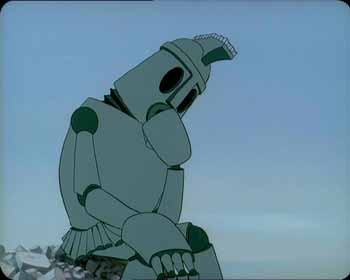
You were probably expecting a different robot from this guy, who briefly appeared in Paul Grimault's Le Roi & L'Oiseau, first released in 1952. Possibly a black and white steel giant, one whose pilot docks a detachable vehicle in his head? A super-alloy robot with voice-activated weapons, like rocket punches?

Yeah, yeah. I've been promising a Mazinger Z column for quite some time. For me, talking about the prototypical super robot is easy on its face—I grew up watching a bowdlerized version of the show on TV—but it'll be a fun exercise to try and fit the entire animated Mazinger oeuvre into the frame of this piece. The story begins about how you'd expect: busy young manga artist Go Nagai wants to launch a new title with a robot hero, but can't quite figure out how to put a new spin on the concept. Then, while eyeballing a traffic jam, a thought occurs: wouldn't the frustrated drivers in the back run amok if they were at the steering wheels of giant robots instead of regular-sized cars? In short order, Nagai pitched his new idea to Toei and got started on the manga, which debuted in Shonen Jump in October 1972.
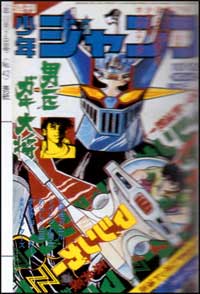
Mazinger Z was an immediate hit, because, in short, it was 20 tons of loud, dumb fun. With a hot-blooded hero, dead/absent father figures, and special attacks galore, Mazinger Z blazed the trail of all super robots that would follow. The lynchpin of the show's success? Mazinger Z itself, a timeless design with a peculiar, grate-covered face, a great color scheme, and an ever-growing array of voice-activated special attacks. In addition to that, Mazinger Z was both a scientific triumph and a weirdly patriotic symbol (after all, Mazinger Z is created using Alloy Z, which can only be refined from Japanium, found only at the base of Mt. Fuji!). The robot was fun to watch, and just as much fun to play with in its many, many die-cast toy incarnations.
For me, Mazinger Z's greatest appeal lies in both its cast of heroes, featuring pilot Koji Kabuto, a boy that is at turns gallant and weirdly antagonistic to his buddies and would-be girlfriend, and in Nagai's typically nutty story ideas. My favorite piece of Mazinger Z plot progression involves the heroes making the sad discovery that Mazinger Z just isn't that effective against flying enemies. Dr. Yumi of the Super Science Institute eventually develops cool detatchable wings for Mazinger Z, but in the meantime, a variety of solutions are employed. The best one is when Sayaka, Koji's partner and flame, launches her girl robot's boob missiles(!), and then this happens:
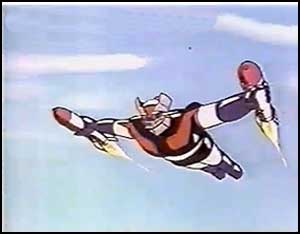
Amazing, right? Another thing that makes the series fun to watch in spite of its titanic 92-episode length and repetitiveness is the assemblage of bad guys. Mazinger Z's bizarre villains are just as much fun as the heroes. A dude and a lady cut in half and sewn together the long way, a headless general who carries his decapitated but still functional head around under an arm, and a ranting, purple-faced mad scientist are the most obvious baddies, but the show is run through with a parade of increasingly weird robots as well—robots with two reptilian heads, robots that resemble charging bulls, robots that soar through the sky like missiles. You never exactly root for Dr. Hell, but you're always glad to see him, plotting his imminent takeover of the world using ancient Mycenaen super robot technology.
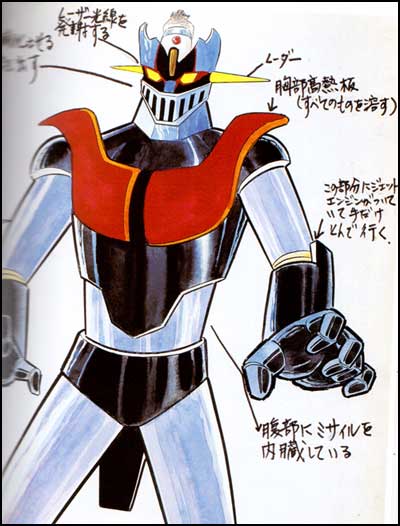
One amusing wrinkle: Nagai's first clear vision of the kind of robot he wanted to make was a bit different from the final product. Instead of the eventual signature red “hover pileder” vehicle, he envisioned the pilot using a motorcycle to dock with and control the robot. This was back during development, when he was calling the robot itself Energer Z. Then Kamen Rider became a big hit, and he realized he'd need to use something besides a motorcycle to make his innovative robot/docking vehicle combo stand out. He'd soon change the robot's name, as well (“Mazin” being a play on “demonic god,” which is explained early on, as dying grandpa Dr. Juzo Kabuto proclaims that the heroic Koji could use its powers to become God, or the Devil!). Nagai would later use the motorcycle for another robot, and Energer Z itself eventually turned up in some unexpected places.
After two years and 92 episodes, what was next for Mazinger Z? Total destruction at the hands of the Great General of the Darkness, that's what. Fortunately, an all-new, all-different Mazinger was waiting in the wings to save the day. Piloted by the orphaned Tetsuya Tsurugi and developed by Kenzo Kabuto, Koji's missing-presumed-dead dad, Great Mazinger boasted a number of improvements—it was bigger and stronger than the original, but lighter and faster. It had built-in wings rather than relying up the variety of “scrander” flying wings that the original Mazinger Z used. It could also harness lightning and do battle with the forces of evil using a pair of giant swords. Basically, it took everything that made Mazinger Z a hit, and kept it going for another 56 episodes.

Of course, it wasn't a straight copy of the formula. As the original show's Koji leaves the fold to study in America, newcomer Tetsuya proves himself a stronger, if still hotheaded, pilot. As the series progresses, he finds himself dogged by his own jealousy of Koji, who still has father figures in his life. His partner, Jun Hono, is also tougher and calmer than the original's Sayaka Yumi—even if her outfit is way sillier, featuring a weird cowboy hat-lookin’ helmet. Mazinger Z and Great Mazinger were big hits, broadly popular, and repackaged for sale around the world. Most importantly, they sold toys. Lots and lots of toys, which led to more sponsorship money, which led to more episodes. That's how a show about a great big silly robot stays on the air continuously for three years, during a time when shows about super robots were a completely new thing. By the time ’75 rolled around the air was thick with imitators, some of them designed by Nagai himself. But Mazinger Z was the super robot original.
Along with the hit TV shows, Mazinger Z also made a number of appearances in theatres. There was the obvious team-up choice involving Nagai's concurrent occult superhero hit Devilman, which begat Mazinger Z vs Devilman. The show's climactic battle was re-imagined for Mazinger Z vs the Great General of Darkness. These movies are fun, compact bits of the franchise, typically thirty or forty minutes long, originally designed to run alongside other Toei fare in matinee film festivals for kids. Ultimately the films existed primarily to provide children with inspiring images like these:

Nagai's super robot lab would eventually use this big-screen format to unleash something of a pilot film on his adoring public; along with the end of Great Mazinger, 1975 saw the film debut of The Great War of the Flying Saucers, in which the dashing alien Duke Freed uses the UFO-powered super robot Gattaiger to do battle with invaders. Sound familiar? It better, because this film was the prototype for the brand new chapter of the Mazinger-verse, UFO Robot Grendizer. Just look at the similarities between the movie and the eventual TV series. They even had the same theme song!
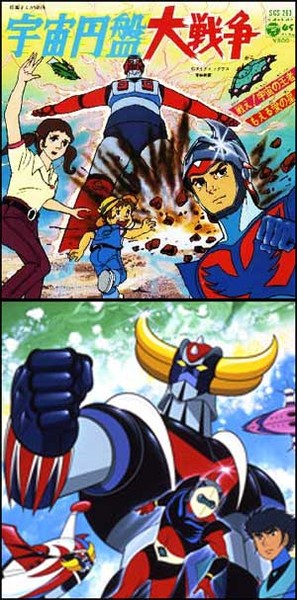
I'm a particularly big fan of Grendizer, since it aired in America as part of the Force Five package that I watched as a kid. While the incredibly awesome robot and its coterie of attacks was unchanged for the dub, Duke was redubbed “Orion Quest.” The rest of the show's localization worked well enough, since Freed worked as a ranch hand in a part of Japan where the whole “cowboy” motif worked just fine. The bad guys hail from the Vega system, which means they're called Vegans, which means I always snicker and imagine them struggling against Freed and his family to stick to a diet without any meat or animal products, rather than bombarding the Freed homeworld with radiation and pursuing Duke across the cosmos. That dubbed version I saw as a kid doesn't hold up that well these days, man. You can hit Youtube and hear it for yourself.
Grendizer didn't link up to the Mazinger mythos as a direct continuation, but it did feature Koji Kabuto as a supporting character, which meant that Grendizer still got to be a part of the “Mazinger family.” That family quit working so hard to save the world from aliens and monsters after Grendizer's end in 1977. After that point, Nagai took his old Toei pals to court over a dispute involving Gaiking, which meant that the Dynamic Planning super robot pipeline would have to be diverted to other studios. I've written a bit about Knack Productions’ Groizer X, which wasn't part of the Mazinger mythos (but which, like Energer Z, would eventually be folded in anyway). But some years later, Nagai would again team up with Knack to produce Psycho Armor Govarian, a show about Isamu Napoto, who uses his fabulous psychic powers to pilot the robotic Govarian against the conquering Garadian Empire and its endless supply of silly robot adversaries. Govarian isn't part of the Mazinger family per se, but just take a gander and note the similarities:

In 1984 Nagai would partner up with TMS to produce God Mazinger, a single-season chronicle of Yamato Hino's bizarre trip to the ancient kingdom of Mu, where he transfers his consciousness into the giant technological wonder of the lost Mu civilization – God Mazinger! The titular robot…? Statue…? Anyway, the titular hero has that classic Mazinger look, with horns up top and a sword on his hip, even if he lacks the power of Z alloy. Interestingly, the show's 23 episodes were supposed to be 24—but while production materials were drawn up for the show's epilogue, it was bumped off the calendar by the ’84 Olympics and never finished, sinking beneath the same waves that claimed Mu and Atlantis.
That would be it for Mazinger Z for the 80s, a decade of robots that kinda looked similar to the classic original if you tilted your head and squinted. This wasn't helped by the fact that Mazinger's broad appeal meant that the series could be rerun, and kids and otaku would still tune in. Nevertheless, I find it interesting that one of anime's big icons took a break between 1975 and 1991. Turns out there was a reason for that.
The reason itself isn't all that complicated—it stems from Nagai and Dynamic's aforementioned legal issues with Toei over Gaiking. When he put up his dukes and filed suit against the animation giant, Nagai vowed to not work with Toei again. This didn't necessarily mean no more Mazinger Z, though. On the contrary, Dynamic got to work mapping out Dai-Mazinger, an OVA redux of the original featuring emerging star animators like Toshihiro Hirano and Masami Obari. But Toei stepped in and put the show on ice, pointing out that they had the rights Mazinger Z in animation form. Dai-Mazinger went back on the shelf, leaving Mazinger Z's true return to animation on hold until 1991. That return wasn't quite what you'd expect, either.
In the meantime, I was a kid, watching Mazinger Z on TV in America. I'm pretty sure the show's ascendancy to UHF television in the mid-80s is pretty much entirely the fault of Voltron's success. At any rate, a production company called Three B Productions got the show to air, with an enjoyably bad instrumental theme song, changed names, and puzzling edits that sometimes mixed Great Mazinger footage with that of Mazinger Z. At the time, I just plain didn't notice. An earlier dub of Mazinger Z, shown only fitfully on CBN's Beyond the Horizon package, remains fondly remembered largely due to its enjoyably incomprehensible Engrish theme song. Mazinger Z’s true return to animation was almost as weird.

In 1991's CB Chara Go Nagai World, Devilman hero Akira Fudo wakes up to see that the world has gone all superdeformed, leaving the now adorably pint-sized Devilman to get to the bottom of this mystery. Koji and Mazinger Z appear as supporting characters, but it's still good to see them again after so long, even if they're only stubby versions of their usual selves. By this point, Dynamic and Toei's icy relationship had thawed, and Toei helped work on the weird meta-comedy.
That'd be it for Mazinger in animation for another ten years, until 2002's Mazinkaiser. Mazinkaiser's interesting for a few reasons. First off, it's produced directly by Dynamic Planning, not Toei. Second, it came in the wake of the advent of the Super Robot Wars video game franchise, which featured Mazinkaiser, an even more amped-up version of the super robot hero, in the Super Robot Wars F Final installment. Finally, rather than being a spinoff of the earlier animation, Mazinkaiser and its attendant designs are based on Go Nagai's Mazinger Z manga.
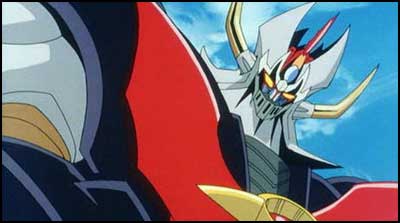
I'm a big fan of Mazinkaiser, which does a fantastic job capturing the sheer fun and weirdness of the original series. The show's bursting with red-hot robot fightin’ action, but also fearlessly pokes holes in the original's motifs, displaying Nagai's comic sensibilities, which were often absent from the original series. The OVA is a showcase for the new Mazinger version, but it gives plenty of screentime to earlier Mazingers, including the best Mazinger of all: Boss Borot! Boss Borot is an ugly, ineffectual robot built by the local bully to try and compete with Koji and Mazinger Z. Despite this (or more likely, because of this), it's remained an incredibly popular part of the franchise, with the loudmouthed, inept Boss allowed to take center stage and save the day on occasion. Aside from Boss's star turn, my favorite part of Mazinkaiser is the voice of Koji. When I first saw the OVAs, I thought, “Wow, that kid playing Koji really sounds like the original!” Turns out it was the original, Hiroya Ishimaru. Kappei Yamaguchi played Koji in CB Go Nagai World, but the original voice, at age 61, returned to the role for Mazinkaiser to show these damn kids how it was done. Mazinkaiser came out in English courtesy of ADV Films, but its capper, a short movie remake of the Great General of Darkness film, never came out in these parts.
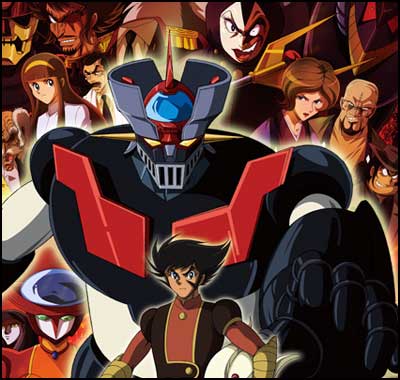
You'd think something like Mazinkaiser would put the cherry on top of the franchise, and not be equaled or surpassed for years. But in this case, you'd be wrong: in 2009 fans were greeted with the incredibly exciting news of an all-new Mazinger TV animation—one helmed by Yasuhiro Imagawa, the mercurial genius behind Giant Robo: The Animation and G-Gundam. What we soon got was Shin Mazinger! Shougeki Z-Hen, a liberal retelling of the entire Mazinger Z myth. Imagawa takes almost every weird, crazy, exciting bullet point in the original a step farther, involving actual gods in the proceedings, and turning the robot's signature rocket punch into a reality-smashing finishing move. He ties the story of Koji and his friends up in new and different ways, even managing to evoke sympathy and admiration for Dr. Hell and his grim, driven companions. Best of all, like every great Imagawa work, Shin Mazinger features a white-knuckle cliffhanger at the end of damn near every episode. You don't need to know Mazinger Z’s history to love this installment—it's a bonus if you do, but you don't—you just have to be down with the super robot aesthetic. Sadly, the show wasn't a big hit, and a planned sequel was quietly shelved. We just can't have nice things, can we?
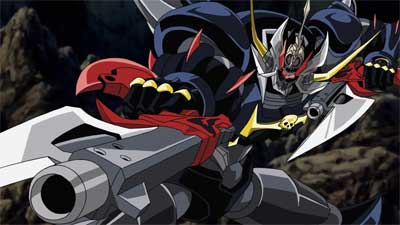
Go Nagai's genre-making all-time classic got yet another update in 2011's Mazinkaiser SKL, but while Imagawa's take embraced the show's classic roots, this OVA iteration, directed by talented by straightforward robot anime director Jun Kawagoe, looks to craft a leaner, meaner Mazinger. The robot itself is as spiky and muscular as Mazinkaiser gets, and bristling with savagely violent special attacks, but unlike 2002's OVA, in this case it's piloted not by Koji, but by Ken and Ryo, a pair of bad-boy pilots voiced by handsome, popular seiyuu. With kinetic action scenes and subtle references to the original, Mazinkaiser SKL is proof that the O.G. super robot formula can work even with today's modern sensibilities—and unlike earlier versions, you can watch Mazinkaiser SKL on Netflix.
Mazinger Z will return to animation. There aren't any concrete plans for a new production, but let's face it, it's going to happen. The kids of the 70s and 80s that grew up loving the series are now big-spending adult collectors, and their kids are discovering the magic courtesy of home video releases and endless waves of new toys and collectibles. Even in America, where Mazinger Z's impact was delayed, the original 1972 show's out there on home video, ready for fans both old and new to enjoy. In creating Mazinger Z and kicking off the super robot revolution, Go Nagai discovered a resilient formula, one almost as strong as Alloy Z itself. I'm sure that his team of super scientists will be cooking up a new robot adventure soon!
discuss this in the forum (20 posts) |